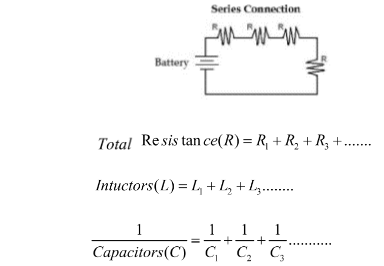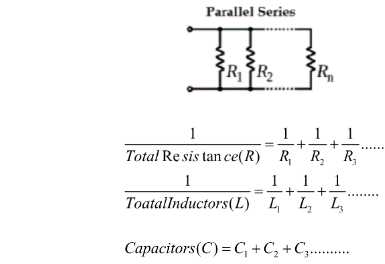We’ve all heard of electricity. It is due to the flow of electrons. As a result, the term electricity is derived from the word electrons. A battery does not work because there is no passage of electric current if it is held up in air. As a result, you require a circuit. In layman’s terms, an electronic circuit is a closed pathway through which electrons can flow.
Electric current flows from positive to negative in a circuit, while electrons flow from negative to positive. When the switch is turned on, the path is complete and electricity flows through, allowing the bulb to light up, whereas when the switch is turned off, the flow of electricity is interrupted and the bulb does not light up.
Circuits can be found in any electrical device you use, including your switchboard, television, refrigerator, and laptop.
Circuits
A circuit is a collection of electronic components that have been assembled and interconnected to perform a specific function. Electronic circuits are classified into two types: digital and analogue. We will concentrate on digital but will touch on analogue because many applications require both. The term circuit refers to the fact that electric power must flow from a power source’s positive terminal through one or more electronic devices and back to the power source’s negative terminal, forming a circuit. If the connections between an electronic device and either the positive or negative terminals of a power supply are broken, the circuit is broken and the device is rendered inoperable.

Types of Circuits
You’ve probably heard the terms electrical and electronic. First, let’s define the distinction between these two terms. While electricity is the foundation of all things, electronics are a subset of electricity. An electrical circuit only deals with the flow of electrons and has components such as resistors, inductors, and capacitors and uses an Alternating Current Source, whereas an electronic circuit deals with current transformation and controlling the motion of electrons and uses a Direct Current Source. An electrical circuit is called passive because it lacks any components that react to the current/voltage that passes through it, whereas an electronic circuit is called active because it contains additional components that react to the current/voltage that passes through it, such as a diode or a transformer.
A circuit’s components can be arranged in a variety of ways, the most basic of which are series and parallel.
Series Circuit
An electrical circuit only deals with the flow of electrons and has components such as resistors, inductors, and capacitors and uses an Alternating Current Source, whereas an electronic circuit deals with current transformation and controlling the motion of electrons and uses a Direct Current Source. If you connect three lamps in series to the same power source, the first one will receive more voltage than the last.

Parallel Circuit
A parallel series is formed when the components are connected in a parallel format. In this type of connection, all of the components would receive the same voltage, while the current would be distributed among them.

Voltage and Electric Current
An electric current is defined as the free flow of electrons, and the driving force behind that free flow of electrons is referred to as voltage. Voltage is a measurement of the potential energy required to move electrons between two points. Voltage is the force that electrons need to move within a circuit. Volts are used to measure voltage, and Amperes are used to measure current.
Ohm’s Law
According to Ohm’s law, the current flowing through a conductor between two points is directly proportional to the potential difference between those two points. It means that the greater the resistance, the less current flows. I = V/R This holds true for any component of a circuit. Conductors, for example, would increase current flow while inductors would decrease it.
Integrated Circuits
These are commonly referred to as ICs. They are commonly found in the form of chips and microchips. This is a collection of various electronic circuits on a small semiconductor device (normally silicon). These integrated circuits (ICs) have proven to be extremely useful as technology has advanced. They can be found in any electronic device you can think of. Computers, mobile phones, and other digital appliances all contain multiple integrated circuits (ICs). Their main components are Diodes, transistors, and microprocessors. The device’s memory is provided by microprocessors. Electronic devices can perform logical or protocol applications with the help of a microprocessor.
Physics has always been an important part of our lives and education. Everyone, from elementary school students to engineering students, is well-versed in physics concepts. Understanding Circuit is one of the most important aspects. Even if you aren’t a physics major or haven’t paid much attention to the subject in school, you can understand a circuit in layman’s terms. In the same way that the organs of a human body are required to make it function, a circuit is required to make any electrical or electronic device function. It serves as a conduit for electric current to reach your lights, fans, and other electrical appliances.
Every system, from the smallest digital device to the largest electrical item you own, contains a circuit. You have probably heard the term “short circuit” a million times at home. That is nothing more than a faulty connection between two points of an electric circuit with two different voltages, resulting in excessive current flow and circuit damage.
Conclusion
We’ve all heard of electricity. It is due to the flow of electrons. As a result, the term electricity is derived from the word electrons. A battery does not work because there is no passage of electric current if it is held up in air. Circuits can be found in any electrical device you use, including your switchboard, television, refrigerator, and laptop. A circuit is a collection of electronic components that have been assembled and interconnected to perform a specific function. Electronic circuits are classified into two types: digital and analogue. We will concentrate on digital but will touch on analogue because many applications require both. An electrical circuit only deals with the flow of electrons and has components such as resistors, inductors, and capacitors and uses an Alternating Current Source, whereas an electronic circuit deals with current transformation and controlling the motion of electrons and uses a Direct Current Source. An electrical circuit only deals with the flow of electrons and has components such as resistors, inductors, and capacitors and uses an Alternating Current Source, whereas an electronic circuit deals with current transformation and controlling the motion of electrons and uses a Direct Current Source. A parallel series is formed when the components are connected in a parallel format. An electric current is defined as the free flow of electrons, and the driving force behind that free flow of electrons is referred to as voltage. According
 Profile
Profile Settings
Settings Refer your friends
Refer your friends Sign out
Sign out




